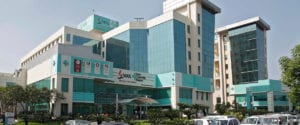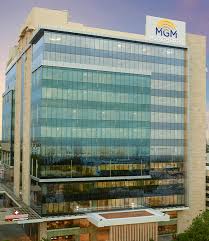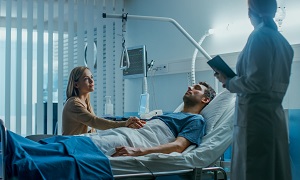Best Brachytherapy Doctors & Hospitals in India
Best Brachytherapy Hospitals India
- City: Mumbai, India
Hospital Highlights:
- Kokilaben Dhirubhai Ambani Hospital, Named after the wife of Indian industrialist Dhirubhai Ambani, the founder of Reliance Industries, this is one of the top hospitals in Mumbai. This 750-bed multi-specialty hospital became operational in 2009. Known as one of India’s most advanced tertiary care facilities, the hospital is designed to raise India’s global standing as a healthcare hub, with an emphasis on excellence in clinical services.
- Kokilaben Dhirubhai Ambani Hospital uses Protocol and Care Pathway based treatment models to ensure the best outcomes for patients.
- The hospital represents a confluence of top-notch talent, cutting-edge technology, state-of-the-art infrastructure, and, most importantly commitment.
- The hospital also holds the accreditation of the NABH, NABL, CAP, and JCI.
- The hospital has been recognized as the No. 1 Multispecialty Hospital in Mumbai and the West Zone for the fifth year in a row in 2020 by The Week.
Hospital Highlights:
- Lilavati Hospital & Research Centre is India’s premier multi-speciality tertiary care hospital and has been recognised as a global medical excellence centre.
- Lilavati Hospital & Research Centre has built an unrivalled level of trust with its patients over the years, thanks to a solid foundation that comprises cutting-edge facilities, the best medical competence, research, education, and charity endeavours.
- The hospital is quite proud of the fact that it now serves patients from all kinds of backgrounds, not just from the United States but from all around the world.
- The hospital has a total of 323 beds, one of the largest Intensive Care Units (ICUs), 12 Operation Theatres with modern amenities, over 300 consultants, and almost 1,800 personnel.
- City: Bengaluru, India
Hospital Highlights:
- Established in 1991, Manipal Hospital, Old Airport Road, Bangalore is the flagship facility of the Manipal Hospitals Group, which is one of the largest networks of Multispecialty Private Hospitals in India.
- The facility is well-known for its state-of-the-art technology, performance-driven, patient-centric, and evidence-based approach.
- The facilities offered at Manipal Hospital meet the highest international standards, allowing the hospital to attract a large number of national and international patients.
- Their expertise encompasses the diagnosis and treatment of a wide range of diseases in several specializations that address both simple as well as complex medical procedures.
- There are total 600 beds accessible in the hospital for the in-patients so they may heal while being closely watched after by the medical team. In addition, it has 144 critical care units, including NICUs, ICCUs, and ICUs. Apart from that, the hospital also offers 20 contemporary, modular state-of-the-art operating rooms with all the amenities needed.
- The hospital has several departments that are overseen by highly skilled, certified, and experienced medical experts.
- One of the best departments in the hospital is that of the Cancer department which is known for its advanced cancer diagnosis and treatment facilities such as Intracavitary Chemotherapy, Biological Therapy, HIPEC, PIPEC, Nuclear Medicine, Radiation Therapy, etc.
- It is one of the few hospitals in Bangalore that provides full range of pediatric services, including pediatric emergency services, pediatric gastroenterology, pediatric neurology, pediatric cardiology, pediatric orthopaedics, pediatric allergies, pediatric immunology, and infectious diseases.
- Furthermore, Manipal Hospital, Old Airport Road, Bangalore is also regarded as one of the best hospitals for bone and spine related disorders.
- City: New Delhi, India
Hospital Highlights:
- Manipal Hospitals, Dwarka, is a super-specialty hospital in Dwarka, New Delhi, which is a part of Manipal Hospitals Group.
- The hospital aims to provide the best treatment on par with international standards at a fraction of the cost.
- Equipped with 380 beds, the hospital is also one of the new age hospitals which are equipped fully with state-of-the-art infrastructure, cutting-edge technology as well as the latest and advanced clinical practices. The hospital also has 13 modular Operation theatres with 118 beds which are solely meant for critical care.
- The hospital comprises internationally acclaimed doctors and highly professional and experienced hospital and medical staff who are able to provide preventive, therapeutic, and diagnostic services all under one roof.
- City: Faridabad
Hospital Highlights:
In the sprawling city of Faridabad, where healthcare needs are diverse and ever-evolving, one institution has consistently stood out as a beacon of excellence in the field of medicine—Marengo Asia Hospital. Established with a vision to provide world-class healthcare services to the community it serves, Marengo Asia Hospital has emerged as a trusted name synonymous with quality, compassion, and innovation in healthcare.
- City: New Delhi, India
Hospital Highlights:
- One of the well-regarded providers in India committed to the highest standards of clinical excellence and patient care, Max Super Specialty Hospital is a part of Max Healthcare, which is the second-largest healthcare chain in India. Regarded as one of the most well-regarded healthcare providers in the country, Max Super Specialty Hospital is committed to the highest standards of clinical excellence as well as patient care. The hospital is also equipped with the latest technology as well as cutting-edge research. The hospital is known to deliver and ensure the highest level of patient care.
- The hospital has more than 500 beds and offers treatment for over 35 specialties. The hospital also holds the credit of having installed the first Brain Suite in Asia. This is a highly advanced Neurosurgical machine that allows MRI to be taken while surgery is ongoing.
- Other advanced and latest technologies are also installed in the hospital such as the 1.5 Tesla MRI machine, 64 Slice CT Angiography, 4D ECHO, LINAC, and 3.5T MRI machine.
- City: Gurugram, India
Hospital Highlights:
- One of India’s best and largest multi-specialty hospitals, Medanta was built with the aim to bring India to the highest standards of medical care. The hospital has been providing the best medical services to its patients, since its inception, with care, commitment, and compassion.
- Equipped with 1250 beds, the hospital was founded by Dr. Naresh Trehan in the year 2009 with an aim to provide the best medical care at affordable costs. The hospital is spread across 43 acres and includes 45 operation theatres and 350 beds dedicated solely to ICU. The hospital includes over 800 doctors, and more than 22 specialty departments and has a dedicated floor for individual specialty in order to offer the best services under one roof.
- The hospital is considered one of the premier institutes in India for Cardiac Care and includes staffs and members of high caliber. The hospital has 6 distinct centers of excellence.
- City: Chennai, India
Hospital Highlights:
- Located in Chennai, India, MGM Healthcare is a top multispecialty hospital that provides all medical services under one roof.
- Since its founding in 2019, MGM Healthcare has quickly become a leading national referral centre, creating several innovative flagship initiatives.
- MGM Healthcare combines next-generation medical and digital technologies to provide better patient results.
- With 12 centres of excellence, more than 400 inpatient beds, 100 intensive care unit beds, and 24/7 emergency care, MGM Healthcare leaves no chance in redefining the patient experience in Chennai.
- MGM Healthcare boasts 250+ expert doctors across 30+ departments, including Cardiology, Pulmonology, Neurology, Obstetrics & Gynaecology, and more.
- They house 12 specialized Centres of Excellence, including Neurosciences, Orthopaedics, and Multi-Organ Transplantation.
- Their team of doctors, nurses, and paramedics works together to give every patient individualized treatment.
- City: Gurugram, India
Hospital Highlights:
- Situated near DLF Cyber City, Gurugram, Narayana Superspecialty Hospital is one of the top medical facilities in the Delhi NCR region, catering to the needs of the people. Known for its commitment to quality medical care and patient service, the hospital is a state-of-the-art facility with planned and well-equipped sections, which includes a spacious OPD area as well as comfortable patient rooms.
- It is the closest super-specialty hospital from Indira Gandhi International Airport towards Gurugram, and also the nearest super specialty hospital from DLF Cyber City. It is also close to major residential areas in Gurugram.
- It is part of the renowned Narayana Health Group. Established in 2000, by Dr. Devi Shetty, a renowned cardiac surgeon, it has grown to be one fo India’s leading healthcare groups.
- City: Gurugram, India
Hospital Highlights:
- Paras hospital was established in 2006 and is the 250 bedded flagship hospital of Paras Healthcare.
- The is supported by a team of doctors of international and national repute.
- The hospital is NABH accredited and also the first hospital in the region to have a NABL accredited laboratory.
- The hospital provides specialty medical services in around 55 departments including Neurosciences, Joint Replacement, Mother & Child Care, Minimal Invasive Surgery, Gynecology and Obstetrics, Ophthalmology, Dermatology, Endocrinology, Rheumatology, Cosmetic and Plastic surgery.
- The hospital is equipped with state-of-the-art technologies.
Brachytherapy
Gone are the days when Cancer Treatment only meant chemo or external radiation therapy. Thanks to the medical science advancement, cancer treatment methods have undergone some recent changes with new, more focused treatment methods cropping up on the scene! Brachytherapy is one such treatment method that focuses on cancer tumors by placing small radioactive implants as close to the tumor location as possible.
One of the primary reasons why Brachytherapy is recommended, because this therapy focuses on high doses over a small space with the radiation concentrating on the tumor and not on the surrounding tissues or cells. This prevents damage or harm to the surrounding areas of the tumor.
Now you must be wondering how Brachytherapy works with such precision and we’ll get to that, but before we do, let’s breakdown the basics of this treatment style starting with the question-
What is Brachytherapy?
In its simple form, Brachytherapy can be defined as a type of internal radiation in which an implant, which can be anything from wires or seeds to capsules, with a radiation source in it is directly placed inside the body, closer to the tumor. Also known as Internal Radiation Therapy, this form of therapy can effectively shrink the tumor size if not downright eliminate it from your system and can be used to treat cancer types such as-
- Lungs
- Breast
- Prostate
- Head & neck
- Eye
- Uterus, etc.
What are the Different Brachytherapy types?
Primarily, there are two types of Brachytherapy:
Low Dose Rate (LDR) Brachytherapy
- Low Dose Brachytherapy also known as permanent brachytherapy, is a continuous treatment process where a radioactive implant is permanently inserted (either manually or through a machine) in your body and a low dose of radiation seeps out of it continuously for weeks, maybe months, depending on the intensity or growth rate of the tumor. The radioactive implant will release a particular dose of radiation and would focus on gradually shrinking or weakening the tumor.
- In this procedure, you may be asked to detain yourself in the hospital due to the presence of radiation within your body. Even though it’s not harmful, you’ll be kept in a private room with limited visitor access (no children or pregnant women).
- The insertion of the brachytherapy device will not be painful since in most cases anesthesia is used to reduce discomfort. In fact, the presence of the radioactive implant in your body shouldn’t cause any pain or discomfort and if it does, notify your medical team immediately.
High Dose Rate (HDR) Brachytherapy
- High Dose Brachytherapy also known as temporary brachytherapy, is more of a session-wise treatment procedure where radioactive implants are temporarily placed within the body and the therapy continues for a few minutes, up to half an hour itself. Post this, the temporary radiation tube is removed and you can return back to your normal lifestyle without any hassle.
- Since HDR Brachytherapy session is brief, these are recommended for outpatients only which means you don’t have to stay back in the hospital or in isolation. Your medical team may recommend up to 2 sessions of a few minutes each in a day and once the tube is removed, you are free to go. You will also not be radioactive which means you can meet people after your session.
- During the HDR procedure, the radioactive material will be inserted using a computerized machine. Your medical team will leave you alone in the room to avoid unwanted exposure but they will closely monitor you from a nearby room. You can notify them if you feel discomfort or pain, but in most cases, the patients don’t. Once the procedure is done, your medical team will come back in, remove the radiation device and you’ll be free to move about.
Who will your medical team consist of?
Much like any other cancer cure team, there will be some core professionals consisting of radiation oncologists, radiation therapists, dosimetrist to measure your dose, a general physicist on standby (for health ailments occurring during the procedure). There will also be a support team of anesthesiologists, surgeons (to insert or extract implants) and nurses for general care during and after the procedure.
How do you prepare for your brachytherapy?
Once diagnosed and determined, your medical team will decide if Brachytherapy is a suitable option for your condition. Once determined, you will be asked to share a detailed report of your medical history including ongoing medications, health supplements, etc. Consult with your healthcare team for dietary regulations and if any is necessary or not! Your doctor may prescribe certain clinical tests to understand your condition better which can be in the form of :
- EKG
- MRI/ CT scan / Ultrasound
- Certain blood tests
- Chest X-Ray or other imaging tests
- Bowel preparation
What to expect during the Brachytherapy procedure?
Now let us give you a step by step breakdown of what you might expect during this procedure!
Pre-procedure
You’ll have a brief meeting with your medical team before the Brachytherapy procedure during which your doctor/nurse will go over some preliminary exams which may include imaging tests, physical exams, discussing the procedure including side-effects and so on. During this period, patients are requested to share an in-depth report of their medical histories which should also include ongoing medication, intake of health supplements or blood thinners such as aspirin and more. You can even discuss post-procedure care along with dietary regulations or preventative measures.
During the procedure
So by now, you’re aware that Brachytherapy requires focused radiation to eliminate cancer cells, but are you aware of where the implants are placed? Even though the aim is to place the implants as close to the tumor as possible, there are a lot of variables that need to be taken into account. For instance, there are 3 primary locations that are frequently used and they can be:
- Intracavitary Treatment- In this method, the implant is inserted inside cavities within the body, such as uterus or breasts
- Interstitial Treatment- In this method, the implant is inserted right inside the tumor mass.
- Internal Radiation Therapy- In this method, the radiation is inserted in the form of a medicine, preferably through a vein or into a body cavity.
Depending on the procedure type you may have to stay back in the hospital for a few nights or be in an isolated room while your temporary radiation procedure takes place. You can refer to our Different Brachytherapy Types segment to know more about this.
Post-procedure radiation management & brachytherapy
There is always a chance that the radiation source in your body may make you radioactive for a brief span of time which is why patients are often requested to stay indoors, preferably isolated for a while. This is more common in high-dose brachytherapy where the radiation source is implanted inside the body.
This also means visitors with chronic illnesses, children and pregnant women should avoid coming in contact with you. In fact, visitor meet and greet should be kept zero or at the minimum to avoid unnecessary exposure.
FAQs
1. What are some of the Brachytherapy side effects I should be aware of?
Both LDR and HDR may come with certain side-effects. The most immediate ones that occur right after the procedure can be urinary problems including blood in the urine or frequent need to pass urine. Some later symptoms may include constipation.
2. How long will the implant stay in my body?
This solely depends on your cancer cure rate. Depending on the severity of the condition or your body’s reaction to this procedure, the implants may stay for weeks and even months. However, once the radiation oozes out of the implants, they won’t stay active anymore.
3. How would doctors know if the procedure is working or not?
4. Will I feel pain and discomfort during this procedure?
Even though the implant plantation itself can be a little painful (which is why doctors use anesthesia for this part), once the implant is inside, you shouldn’t feel any pain or discomfort.













